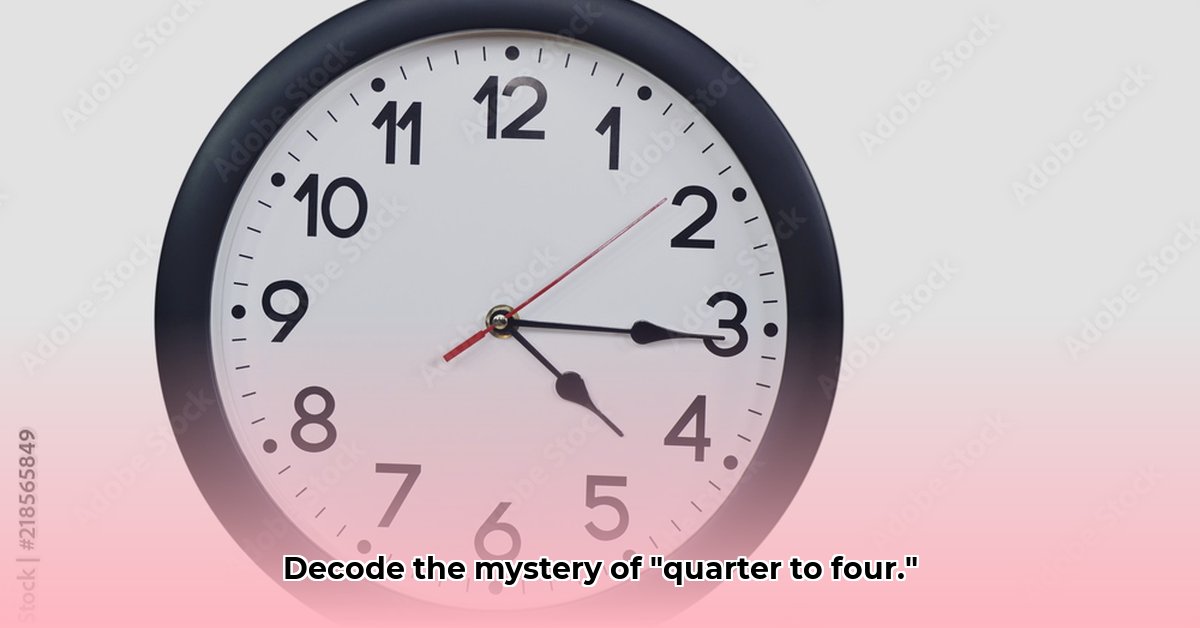
Quarter After Four: Decoding a Timeless Phrase
Ever wondered why we say "a quarter to four" instead of "3:45"? This seemingly simple phrase offers a fascinating glimpse into the history of language and timekeeping. Its origins lie in a pre-digital era where dividing the hour into four 15-minute segments – "quarters" – was a practical approach to time management. Before precise clocks, approximating time in quarter-hour increments was both efficient and sensible. This practice wasn't merely mathematical; it reflected a cultural understanding of the day's flow. The phrase "a quarter to four," therefore, isn't just a way of telling the time; it's a linguistic time capsule.
This system of quarter-hours likely predates widespread mechanical clocks, emerging from earlier, less precise timekeeping methods. The enduring use of the quarter-hour, even in our digital age, highlights its inherent practicality. Why do we persist with this method, even with access to second-by-second accuracy? Perhaps it's a testament to a system's inherent usefulness. The persistence of minute-based timekeeping on digital clocks further reinforces this intuitive division of time.
The shift from the formal "3:45" to the more informal "a quarter to four" demonstrates language's adaptability. While precise numerical time is crucial for scheduling, casual conversation benefits from simpler expressions. Using "a quarter to four" is a demonstrably more efficient way of communicating time in speech. This serves as a prime example of language's evolution to suit specific contexts. This is particularly true when considering the speed and efficiency of spoken communication.
Interestingly, this informal phrasing possesses a degree of inherent flexibility. "A quarter to four" rarely indicates precisely 3:45. More often, it signifies a time within a broader timeframe, perhaps between 3:40 and 3:45. This inherent fuzziness contributes to the expression's charm and reflects the fact that in everyday speech, approximate timing often suffices. Precision is less critical than prompt communication.
Regional variations in phrasing exist within English-speaking communities. While the core meaning remains consistent, subtle differences in pronunciation or usage prevail. For example, the phrasing and frequency of use might differ between the UK, Australia, and the US. This area presents exciting prospects for linguistic analysis, potentially uncovering new insights into language evolution and cross-cultural exchange. What are the corresponding phrases in other global languages? Further research is needed to systematically map these variations.
Even with today's technology, "a quarter to four" remains prevalent. This continued usage emphasizes the phrase's simplicity and efficiency in communicating time. Its persistence speaks volumes about its deep integration into our culture. It’s a simple, easily understood conversational shorthand.
How Regional Dialects Influence the Usage of Time Idioms Like "a Quarter to Four"
Time idioms reveal fascinating regional variations. These differences reflect historical influences and cultural understandings of time.
The "Quarter To" vs. "Quarter Of" Divide
"A quarter to four" is common in British English, intuitively representing 15 minutes before the hour. However, in American English, "a quarter of four" is more frequent, effectively meaning the same but implying 15 minutes remaining until four o'clock. This subtle divergence highlights how regional dialects shape temporal expression. Why this difference? The answer lies in historical linguistic evolution.
This isn't mere linguistic quirkiness; it reflects deeper historical and cultural viewpoints on how we perceive time. The "quarter to" phrasing possibly stems from a literal countdown to the next hour, whereas "quarter of" might originate from older, potentially Scottish-influenced usage. The very evolution of language shapes these differences. Consider the impacts of migration and historical events.
Historical Roots and Linguistic Drift
The "quarter to/of" divergence showcases linguistic drift—minute variations accumulating over time to create substantial differences. Migration patterns, cultural exchanges, and historical events have significantly shaped the current prevalence of these phrases. Language, like time itself, is dynamic.
Beyond "Quarter To/Of": More Time Idiom Divergences
Dialectal differences extend beyond "quarter to/of." The American preference for "ten-thirty" over "half past ten" is another example. Even within the U.S., regional variations exist—for instance, "quarter till" is common in some Appalachian areas. The interplay between geography, culture, and language evolution is deeply interwoven. The adoption of "Nine-Eleven" illustrates how significant events can reshape our perception and communication of time, becoming globally recognized shorthand.
Implications and Further Research
These regional differences are crucial for effective communication, especially internationally. Misunderstandings arising from varying time expressions impact fields like scheduling. Quantitative corpus analysis would deepen our understanding of these time idiom distributions.
Key Takeaways:
- American and British English show distinct variations in time idioms.
- The use of "quarter to" versus "quarter of" highlights diverse temporal perceptions.
- Regional variations even exist within American English.
- These differences reflect historical linguistic evolution and cultural exchange.
- Understanding these variations is critical for clear cross-cultural communication.